We’ve been eating a lot of fermented vegetables lately. We started with kimchi (Homemade Kimchi, Jun 26, 2011), but lately we’ve been fermenting our vegetables in a less spicy style that is normally used for sauerkraut.
“Sauerkraut” means “sour cabbage.” We are not huge cabbage fans, so we often substitute other vegetables. We’ve had good results from Daikon radish, red radish, carrot, celery, and cabbage; the only vegetable we didn’t care for was parsnip.
This is a really simple procedure – mix salt, water, and vegetables with a few spices; leave in a cool, dark sealed container for 7-10 days; eat.
For safety, the key is to give enough time for the water to become acidic. Wikipedia explains the evolution of the bacterial population:
The fermentation process has three phases. In the first phase, anaerobic bacteria such as Klebsiella and Enterobacter lead the fermentation, and begin producing an acidic environment that favours later bacteria. The second phase starts as the acid levels become too high for many bacteria, and Leuconostoc mesenteroides and other Leuconostoc spp. take dominance. In the third phase, various Lactobacillus species, including L. brevis and L. plantarum, ferment any remaining sugars, further lowering the pH. There are unpasteurized sauerkrauts on the market. Properly cured sauerkraut is sufficiently acidic to prevent a favorable environment for the growth of Clostridium botulinum, the toxins of which cause botulism.
Klebsiella and Enterobacter are potentially pathogenic bacteria, but the later Leuconostoc and Lactobacillus species are probiotic. So the more acidic the water, the better the mix of bacteria.
Another good tactic is use predominantly low-calorie vegetables. Keeping sugar levels low will help keep the yeast population down.
First Batch: Daikon radish, celery, carrot
Here were the raw materials for one batch:
We could have cut the white Daikon radish pieces smaller, but this size did fine: by day 7 they were softened all the way through.
Sea salt, ginger, garlic, and peppercorn are seasonings we consider essential; green onion and red pepper have worked for us as well.
You’ll need a large glass or ceramic container that seals. If it is glass, keep it in a dark cabinet while fermenting to avoid light exposure. We like to look at ours in progress, so we bought glass containers.
Fill the glass container about 80% full with diced vegetables, then cover with water so the container is 90% full. Add enough sea salt that the water tastes salty, but not undrinkably so. Also add the other seasonings – ginger, garlic, peppercorn, and any others you choose.
The container will now look like this:
Now it has to be covered with an air-tight seal. We placed plastic wrap over the top, wrapped a rubber band around the jar, and then sealed the lid over the wrap:
After a week it will look like this:
Note how cloudy the water has become.
After a week you should be able to start removing vegetables to eat. Here are some vegetables:
It’s also a good idea to remove the cloudy fluid and drink it. This makes a great “soup” or beverage along with your meal.
As you remove fluid, add water and sea salt to replace what you took. When you run out of vegetables, add a new batch of diced vegetables to the old fluid and let it ferment for a week.
Second Batch: Daikon radish, green onion, and red radish
This first try was so successful we bought a larger glass container and made another batch, this time including red radish. Ingredients:
Here it is ready to go into a dark cabinet for fermentation:
And here it is a week later:
All the red skin pigment has come off the radishes and into the fluid. Here is a bowl of vegetables and fluid:
We’ve been eating two bowls a day, one at dinner and the other at breakfast or lunch.
Other Tips
Try to keep the fermentation jar sterile. We replace the wrap every time we open the container, and keep the lid region dry at all times: if any fluid spills on it as we take vegetables out, we dry the top of the jar with a paper towel. (Bacteria need moisture to thrive.)
If you have concerns about the bacteria on your vegetables, sprinkle salt over them and let them sit for a bit, then rinse the vegetables before dicing them and adding them to the container. This salting will help sterilize the surface a bit.
Conclusion
Even if you don’t like vegetables, you’ll probably like this. Fermented vegetables are surprisingly tasty. Moreover, the fluid is also very tasty. It makes a healthful hydrating beverage, and a great accompaniment to a meal; the acidic fluid helps clear the palate and improve the taste of foods.
We couldn’t be happier with our vegetable fermentation. It makes vegetables taste great, provides us with helpful probiotic flora and lactic acid, and is exceptionally easy to prepare. No cooking necessary!







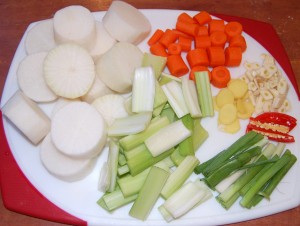
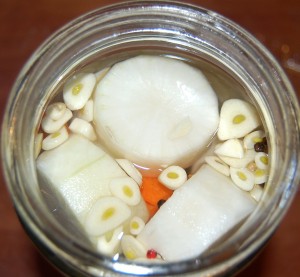

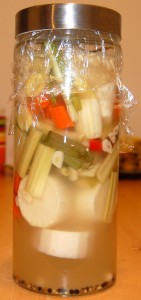
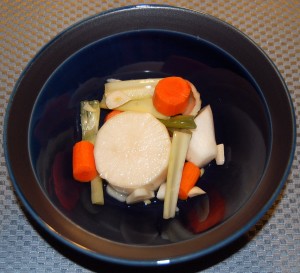
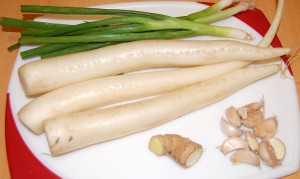
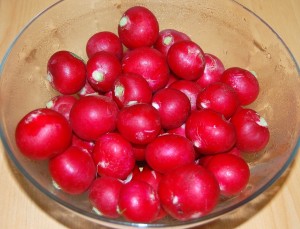
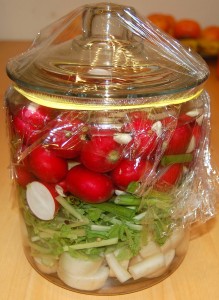
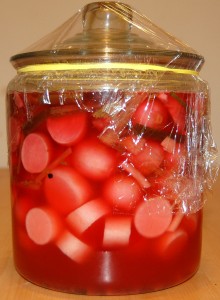
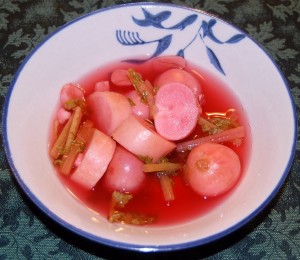




Leanne
Yes, when they have fermented enough put the in tme fridge.
Hey Paul!
I’m loving your blog, I also bought your book recently and it’s awesome!
Just a quick question about the fermenting process.
Some people suggest to release the pressure of the glass jar every day or so when fermenting vegetables. What’s your experience with that? Is it safe to let the glass jar sit for 7 days straight, or what do you do to avoid pressure buildup?
I hope you can help me here!
Thanks
Alen
Have you fermented kohlrabi? any type of turnips?
I’m curious because the end of Winter Farmers’ Markets is coming at the end of next week in Cambridge/Somerville
thanks!
Those are my favorite things to ferment! I do them various ways. Grated, like a kraut, or in chunks. The turnip is especially good grated. Usually i make that just plain. But add thing when doing chunks. Sometimes with onions or scallions, garlic red pepper. Or mixed with carrot and some kelp and sweet red pepper. Garlic and dill are good too.
Hi Ellen,
Are you saying that kohlrabi is your favorite ferment? What do you add besides brine?
They’ve had great kohlrabi at the winter farmers markets in Eastern Mass–a storage variety not the smaller summer type.
What type of turnips do you use?
Thanks!
Yes both kohlrabi and turnips are favorites of mine for ferments. I don’t know about those storage kohlrabi. how big are they? I just use the ones we grow in our garden in the spring and then in the late summer, early fall
As for turnips I use the kind with the purple tops as well as the smaller japanese ones.
If i grate them , either turnip or kohlrabi, I just add salt and then let them release their juices, just like making sauerkraut.
If I cut them in chunks I will add whatever takes my fancy. Some combinations i have done are
red onion and dill
Garlic, kelp and carrots
Carrot, onion, basil
Ginger, garlic, scallions, red pepper flakes
Hia there,
I’ve been reading and enjoying PHD book, thanks for that, what a body of work – it’s so informative – and the blog too.
I want to try making my own fermented veg. Your comments about possible increased cancer risks in the Kimichi page made me think this one might be better.
I have a glass jar with a sealed top (Its Euro style, a glass lid, a rubber ring and a clip that holds the top down).
I see you seal it up tight, I just wondered about it expanding? It’s not going to explode the jar is it?
Is there any good reason to add a starter culture? I read about one that makes it have more vitamin K?
thanks so much, neil
Neil,
In my experience, most of the time there is just moderate pressure, but sometimes there is more. So that is why I use these
http://www.pickl-it.com
There are also these tops for regular canning jars
http://www.perfectpickler.com
Hi Ellen,
thanks,
those jars look great but can’t get them in the UK. I’ll try just putting clingfilm (saranwrap) over the top so it can expand and keep an eye on it!
have a good week
neil
Hi!
I have two questions.
Is it a good idea to sterilize the glassware (perhaps also a ruber gasket) with hydrogen peroxide?
What about pure isopropyl alcohol? Some people claim this substance does not harm rubbers.
Second set. I’ve heard about people who claim to eat safely raw meat (even raw liver) by sterilizing the surface by submerging the piece of meat in a very diluted Lugol’s solution. What about doing the same thing to vegetables before fermenting?
Hi Sarah,
I think cleaning with soap and hot water, rinsing, and letting glassware thoroughly dry is sufficient. Germs can’t survive long without water. You could microwave them too if you wanted to be super careful.
You don’t want to sterilize vegetables before fermenting. The natural microbes contribute to the ferment. Locally grown organic vegetables are good in ferments for that reason.
Thank you!
You’re the best!
Hi
What are your views on kombucha? I make a very nice drink with kombucha and grated beetroot. Then eat the beetroot.
Thanks
Lois
❓ First try at fermenting vegs. Reading all questions and answers, I see no mention of zucchini, which I used. Wish I hadn’t, but I did. Am concerned and
somewhat leery of trying this almost-ready first batch. Comments?
Zucchini tends to produce a very soupy/watery ferment. But, it should be fine to eat, if not as palatable as some other vegetables.
Hi Paul, Great content you have here. Thanks for the hard work that you all put into this site.
Have you ever tried fermenting beets? A friend in France swears by it’s lacto properties.
Take Care,,,,
Thanks,
Aristotle
Hi there
Is it ik to use Himalayan pink salt instead of sea salt ?
It’s OK. Note that Himalayan pink salt has more iron and less iodine than sea salt.
Hi Paul,
Would it be a good idea to add an acid to the ferment at the beginning to speed it up a bit (say a vinegar, lice rice wine vinegar) and/or ferment the vegetables at higher temperatures?
Best wishes,
George
30-40 degrees centigrade, roughly the temperature of the body and gut?